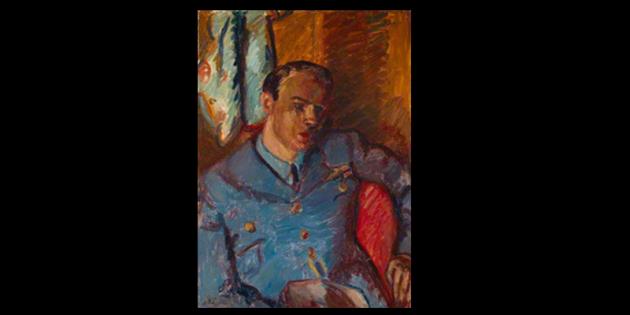A rarely seen portrait of one of the world’s most celebrated writers, Roald Dahl, painted when he was a young RAF pilot during the Second World War by Matthew Smith, has gone on display at the National Portrait Gallery, it was announced today, Wednesday 6 August 2014. The portrait features in a new display bringing together, for the first time, the pioneering modernist work of painter Matthew Smith and sculptor Frank Dobson.
Painted in 1944, when Roald Dahl was in his late twenties and before he achieved international fame as a writer, this large, expressive and colourful portrait shows Dahl in his blue RAF uniform and leaning back in his chair with a solemn facial expression.
The portrait resulted from Dahl’s admiration for Smith, whose work he had seen in a London gallery soon after his plane crash-landed in the Libyan desert and he was declared unfit for combat, forcing him to return to the City. Dahl tracked Smith to his home and made a powerful impression on the artist, who was living reclusively and grieving for his two sons who had both lost their lives in the RAF. Dahl and Smith became lasting friends and Smith had a great influence on Dahl’s future life and career.
Roald Dahl grew up in Cardiff, the city in which he was born, and joined the RAF at the start of the Second World War. After being invalided home to London in 1941 due to serious injuries caused by his plane crash, Dahl was posted to Washington as assistant air attaché. Whilst there, Dahl was asked by the novelist C.S. Forester to write a number of RAF anecdotes to be used as propaganda. The account that Dahl wrote about his experience of the plane crash was so arresting that it was published in full in the Saturday Evening Post, marking the accidental beginning of his career as a writer. Dahl is now considered to be one of the most celebrated storytellers across the globe, particularly known for his darkly humorous children’s stories such as The Witches, Matilda, The BFG and James and the Giant Peach.
Colour, Light, Texture: Portraits by Matthew Smith & Frank Dobson brings together the works of two leading twentieth century British artists, painter Matthew Smith and sculptor Frank Dobson, to show the connections between their individual yet complementary approaches to modernist portraiture. Smith (1879 – 1959) and Dobson (1886 – 1963) were very close contemporaries and, in their respective media of painting and sculpture, both artists had a shared concern for colour, light and texture, and pioneered a modernist response to portraiture. Colour, Light, Texture: Portraits by Matthew Smith & Frank Dobson is the first time that the work of these two artists has been compared and brought together in such a way.
The display includes key portraits by each artist, including novelist and poet Sir Osbert Sitwell, stage actress Margaret Rawlings, and American-born designer Marion Dorn by Frank Dobson. Portraits by Matthew Smith include actress Jean Simmons, Angelica Garnett and a self-portrait. The paintings and sculptures are accompanied by photographs of the artists by Cecil Beaton, Howard Coster, Lola Walker and Berenice Abbott.
Having studied at the Slade School of Fine Art in London, Smith moved to France in 1908. He lived first in Pont-Aven and later in Paris. These experiences acquainted him with the work of the painters Paul Gauguin, Henri Matisse and Wassily Kandinsky whose unconventional use of vibrant colour was a formative influence. In common with Smith, Dobson served in the army during the First World War. After being invalided out in 1918, Dobson turned increasingly to sculpture. Responding to Cubism, Vorticism and other modern art movements, his work focused on the creation of simplified, harmonious shapes involving a variety of different surface qualities. For both artists, portraiture conveyed a sensual, aesthetic experience.
Roald Dahl Portrait By Matthew Smith Goes On Display At The NPG

